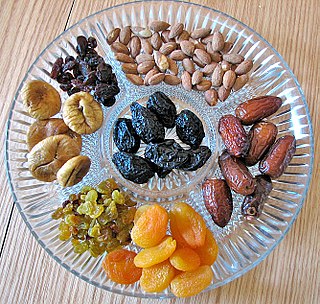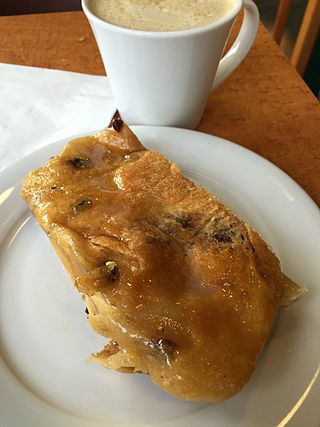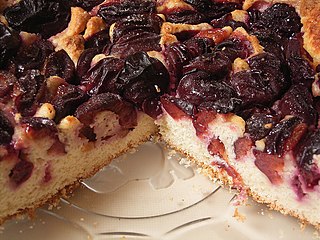Related Research Articles

Turkish cuisine is the cuisine of Turkey and the Turkish diaspora. It is largely the heritage of Ottoman cuisine, which can be described as a fusion and refinement of Mediterranean, Balkan, Middle Eastern, Central Asian and Eastern European cuisines. Turkish cuisine has in turn influenced those and other neighbouring cuisines, including those of Southeast Europe (Balkans), Central Europe, and Western Europe. The Ottomans fused various culinary traditions of their realm taking influences from and influencing Mesopotamian cuisine, Greek cuisine, Levantine cuisine, Egyptian cuisine, Balkan cuisine, along with traditional Turkic elements from Central Asia, creating a vast array of specialities. Turkish cuisine also includes dishes invented in the Ottoman palace kitchen.

A pie is a baked dish which is usually made of a pastry dough casing that contains a filling of various sweet or savoury ingredients. Sweet pies may be filled with fruit, nuts, brown sugar, sweetened vegetables, or with thicker fillings based on eggs and dairy. Savoury pies may be filled with meat, eggs and cheese (quiche) or a mixture of meat and vegetables.

Pound cake is a type of cake traditionally made with a pound of each of four ingredients: flour, butter, eggs, and sugar. Pound cakes are generally baked in either a loaf pan or a Bundt mold. They are sometimes served either dusted with powdered sugar, lightly glazed, or with a coat of icing.

Dried fruit is fruit from which the majority of the original water content has been removed either naturally, through sun drying, or through the use of specialized dryers or dehydrators. Dried fruit has a long tradition of use dating back to the fourth millennium BC in Mesopotamia, and is prized because of its sweet taste, nutritive value, and long shelf life.

Fruitcake is a cake made with candied or dried fruit, nuts, and spices, and optionally soaked in spirits. In the United Kingdom, certain rich versions may be iced and decorated.

Ukrainian cuisine is the collection of the various cooking traditions of the people of Ukraine, one of the largest and most populous European countries. It is heavily influenced by the rich dark soil (chernozem) from which its ingredients come, and often involves many components. Traditional Ukrainian dishes often experience a complex heating process – "at first they are fried or boiled, and then stewed or baked. This is the most distinctive feature of Ukrainian cuisine".

Stollen is a fruit bread of nuts, spices, and dried or candied fruit, coated with powdered sugar or icing sugar and often containing marzipan. It is a traditional German Christmas bread. During the Christmas season the cake-like loaves are called Weihnachtsstollen or Christstollen.

Jewish cuisine refers to the worldwide cooking traditions of the Jewish people. During its evolution over the course of many centuries, it has been shaped by Jewish dietary laws (kashrut), Jewish festivals and holidays, and traditions centred around Shabbat. Jewish cuisine is influenced by the economics, agriculture, and culinary traditions of the many countries where Jewish communities have settled and varies widely throughout the entire world.

Kuchen, the German word for cake, is used in other languages as the name for several different types of savory or sweet desserts, pastries, and gateaux. Most Kuchen have eggs, flour and sugar as common ingredients while also, but not always, including some fat. In Germany it is a common tradition to invite friends over to one's house or to a cafe between noon and evening to drink coffee and eat Kuchen.

A teacake in England is generally a light yeast-based sweet bun containing dried fruit, typically served toasted and buttered. In the U.S. teacakes can be cookies or small cakes. In Sweden, they are soft, round, flat wheat breads made with milk and a little sugar, and used to make buttered ham or cheese sandwiches. In India and Australia, a teacake is more like a butter cake. Tea refers to the popular beverage to which these baked goods are an accompaniment.

Tsoureki also known as Šurēk, choreg or "chorek", çörək (Azerbaijani), çyrek (Albanian), kozunak, cozonac (Romanian) or paskalya çöreği (Turkish) is a sweet holiday bread made with flour, milk, butter, eggs, and sugar and commonly seasoned with orange zest, mastic resin, or mahlab. Lampropsomo, a variation of tsoureki commonly called "Greek Easter bread," is made by Greek communities during Easter, not only in Greece, but also in other countries with Greek communities. It is also sometimes called Armenian Easter bread.

Lardy cake, also known as lardy bread, lardy Johns, dough cake and fourses cake, is a traditional rich spiced form of bread found in several southern counties of England, each claiming to provide the original recipe. It remains a popular weekend tea cake in the southern counties of England, including Sussex, Surrey, Hampshire, Berkshire, Wiltshire, Dorset and Gloucestershire.

Afghan cuisine is influenced to a certain extent by Persian, Central Asian and Indian cuisines due to Afghanistan's close proximity and cultural ties. The cuisine is halal and mainly based on mutton, beef, poultry and fish with rice and Afghan bread. Accompanying these are common vegetables and dairy products, such as milk, yogurt, whey, etc., and fresh and dried fruits such as apples, apricots, grapes, bananas, oranges, plums, pomegranates, sweet melons, raisin, etc. The diet of most Afghans revolve around rice-based dishes, while various forms of naan is consumed with most meals. Tea is generally consumed daily in large quantities, and is a major part of hospitality. The culinary specialties reflect the nation's ethnic and geographic diversity. The national dish of Afghanistan is Kabuli palaw, a rice dish cooked with raisins, carrots, nuts and lamb or beef.

The poppy seed roll is a pastry consisting of a roll of sweet yeast bread with a dense, rich, bittersweet filling of poppy seed. An alternative filling is a paste of minced walnuts, or minced chestnuts.

Plum cake refers to a wide range of cakes usually made with dried fruits such as currants, raisins, sultanas, or prunes, and also sometimes with fresh fruits. There is a wide range of popular plum cakes and puddings. Since the meaning of the word "plum" has changed over time, many items referred to as plum cakes and popular in England since at least the eighteenth century have now become known as fruitcake. The English variety of plum cake also exists on the European mainland, but may vary in ingredients and consistency. British colonists and missionaries brought the dried fruit variety of cake with them, for example, in British India where it was served around the time of the Christmas holiday season. In America's Thirteen Colonies, where it became associated with elections, one version came to be called "election cake".

Vörtbröd is a sweet Scandinavian rye bread, associated with Swedish cuisine. It is a yeast-leavened spice loaf, sweetened with brown sugar and molasses which comes in a large variety in regards to whether or not butter-enriched, and which spices are being used. Traditional bread spices are anise, caraway, fennel seeds, and bitter orange.

Bisciola is an artisanal Italian sweet leavened bread originating from the Valtellina valley of Lombardy, Italy. It is typically prepared for Christmas during which time it is an essential component of Christmas festivities.

Früchtebrot is a sweet, dark bread baked with dried fruit.
References
- ↑ Alan Davidson, ed. (1983). Food in Motion: The Migration of Foodstuffs and Cookery Techniques : Proceedings : Oxford Symposium 1983 · Volume 1. Oxford Symposium. ISBN 9780907325079.
- ↑ Fieldhouse, Paul. The World Religions Cookbook. Greenwood Press. p. 36.
- ↑ "Kletzenbrot (Fruit Bread)". Taste of Austria. Retrieved 2021-12-29.
- ↑ Wolf, Helga Maria (2015). Verschwundene Bräuche: Das Buch der untergegangenen Rituale. Christian Brandstätter Verlag.
- ↑ "It smells like Christmas! - Grandma's recipe for Kletzenbrot (fruit bread) » blogHuette.at". blogHuette.at. 2017-12-12. Retrieved 2021-12-29.
- ↑ "It's the season for holiday baking!". St. Louis Globe Democrat. December 11, 1960. Retrieved 29 September 2020.

- ↑ "Kletzenbrot von Seide | Chefkoch". Chefkoch.de (in German). Retrieved 2021-12-29.